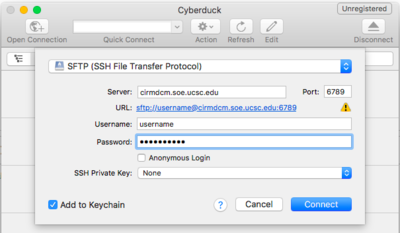Upload onto CIRM-01: Difference between revisions
From genomewiki
Jump to navigationJump to search
No edit summary |
No edit summary |
||
| (2 intermediate revisions by the same user not shown) | |||
| Line 13: | Line 13: | ||
sftp> put -r * | sftp> put -r * | ||
If this shows "No such file or directory", then your sftp is a bit outdated and it doesn't have the -P option yet, try this instead: | |||
sftp -oPort=6789 maxSftp@cirmdcm.soe.ucsc.edu | |||
sftp> put -r * | |||
But sftp is too slow for anything bigger than 100GB. Use lftp for bigger transfers. Here is an example that uploads the current directory and all subdirectories with 10 concurrent connections ("threads"): | |||
$ lftp sftp://myUsername@cirmdcm.soe.ucsc.edu:6789 | $ lftp sftp://myUsername@cirmdcm.soe.ucsc.edu:6789 | ||
Latest revision as of 21:24, 21 June 2018
For CIRM groups
- Ask your UCSC wrangler contact person to set you up with a username and password for the cirmdcm.soe.ucsc.edu sftp upload
- Use an sftp command line client like lftp or simply sftp and connect to sftp://cirmdcm.soe.ucsc.edu, port 6789, using this username
- the "sftp" command is good for basic sftp transfer program of a few files and is installed on most servers and all Mac computers. lftp is using concurrent connections and can be up to 10-20x faster. Lftp is also better in restarting or updating old uploads.
- see below for examples
- If you're unsure which program to use and you want a graphical user interface, not a command line program, a good choice is CyberDuck on MacOS, see image below on how to connect using CyberDuck
- Once you're done with the upload, let your wrangler know
Example command line tool "sftp", usually installed on most linuxes and osx, to upload the current directory and all subdirectories:
$ sftp -P 6789 maxSftp@cirmdcm.soe.ucsc.edu sftp> put -r *
If this shows "No such file or directory", then your sftp is a bit outdated and it doesn't have the -P option yet, try this instead:
sftp -oPort=6789 maxSftp@cirmdcm.soe.ucsc.edu sftp> put -r *
But sftp is too slow for anything bigger than 100GB. Use lftp for bigger transfers. Here is an example that uploads the current directory and all subdirectories with 10 concurrent connections ("threads"):
$ lftp sftp://myUsername@cirmdcm.soe.ucsc.edu:6789 > mirror -R --parallel=10
-R stands for "reverse", a reverse mirror is lftp-speak for "upload".
Example graphical user interface, Cyberduck on Mac OSX:
For UCSC Wranglers
On cirm01, create the user:
sudo /data/create-user username
To change password of user:
sudo /data/change-password username
The new user is created with their homedir as:
/data/sftp/user/incoming
You have read access to those directories.
